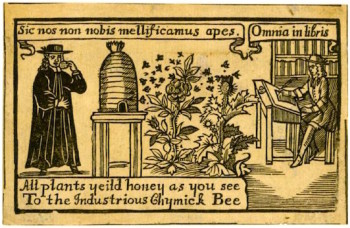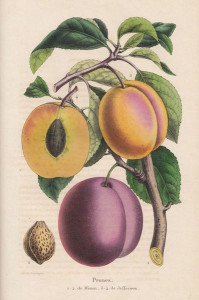Bee Grateful
August 4, 2015
“It is well to remember that the entire Universe, with one exception, is composed of others.”
~ John Andrew Holmes
Did you know that it takes 12 bees, each working their entire lifetime, to collectively produce a single tablespoon of honey?
Meditate on that for a minute. Imagine that you and 11 of your friends devoted your entire lives to produce a spoonful of something that someone else would devour within seconds.
Bees not only produce honey but, along with other pollinators, assist in the production and growth of over 80% of the world’s flowering plants, the plants that produce the fruits, vegetables and seeds that keep us alive and thriving.
There is a reason why talking about sex is euphemistically referred to as “the story of the birds and the bees.” Pollination is how flowering plants reproduce. Pollen is transferred from the male part of the plant to the female part with the help of birds, bees, butterflies and beetles, as they move from flower to flower, usually seeking food or shelter. Bats and moths help to pollinate flowers that bloom after dark.
Honey bees were brought to North America in the 1620’s by early settlers. In the U.S., somewhere between 2,000 to 3,000 commercial beekeepers manage honey bee colonies as livestock, traveling from farm to farm, across the country, to provide pollination services to crops. Even if you are a strict vegan and do not eat honey, bee labor is responsible for pollinating many of the fruits and vegetables that make up your diet.
If bees alone disappeared, so would plums, apricots, peaches, guavas, cherries, almonds, onions, cucumbers, celery, carrots, lemons, limes, avocados, broccoli, cauliflower, eggplant, strawberries, blueberries, raspberries, cabbage, chili peppers, bell peppers, melons, tangerines, coffee, cardamom, sunflowers, apples, pears, beans, tomatoes, grapes and so much more. If butterflies and other pollinators were also to vanish, the list of missing foods becomes much longer.
In the United States, honey bees have been in serious decline for over thirty years. Even free and wild pollinators, such as bumble bees and monarch butterflies, have suffered population decreases. Climate change, pesticide and herbicide use, as well as habitat loss have probably all contributed to declines in pollinator health and numbers.
In May of this year, the White House’s Pollinator Health Task Force (yes, I know that sounds serious, and it is; our food supply is at risk) released the National Strategy to Promote the Health of Honey Bees and Other Pollinators. The plan outlines three main areas of focus:
~ Reduce honey bee colony losses.
~ Increase the Eastern population of the monarch butterfly
~ Restore or enhance 7 million acres of land for pollinators over the next 5 years through Federal actions and public/private partnerships.
The White House plan also calls on individuals to help in pollinator conservation. As a citizen of the world and an eater of food, here are four things you can do to help:
1) Don’t herbicide your lawn – a green lawn is nothing but a dessert for pollinators (and, in California, they are a desert that drinks up valuable water during the drought).
2) Start a garden – planting flowers helps to feed pollinators (many homeowners in California are replacing their lawns with drought-friendly and pollinator-friendly native plants).
3) Support your local beekeepers – buying local honey keeps them in business and is healthier for you and the bees (much of the mass-produced, filtered honey is mixed with honey from China, some of which is cut with fillers, such as rice syrup). Know where your honey comes from and how it was produced by getting to know your local beekeepers and their honey.
4) Educate yourself on the details of pollination – know how the process works and which pollinator-friendly plants thrive in your area.
For more information on pollinators, you can visit the USDA Forest Service site by clicking here.
For local beekeepers in your area, visit localharvest.org
A copy of the National Strategy can be found here.
~~~~~~~~~
Summer is a great time for grilling and for being grateful. Grilled Plums and Pound Cake with Cardamom Mascarpone will have you doing both with gusto.
Grilled Plums and Pound Cake with Cardamom Mascarpone
Plums are abundant in summertime. Grilling them up with slices of prepared pound cake and topping it all off with chilled, spiced mascarpone is a unique and delicious way to enjoy an elegant dessert outdoors. Use a good quality, sweet and syrupy Balsamic vinegar or even a Balsamic glaze for this recipe. I used Séka Hills Elderberry Balsamic Vinegar (sekahills.com)
Seeds from 2 cardamom pods (about 18 seeds)
3 tablespoons local honey
1 tablespoon Balsamic vinegar
1 inch piece of vanilla bean
3 large or 6 smaller plums
1 (10 to 12 oz) prepared pound cake, cut into 6 slices
1 (8 oz) tub of mascarpone cheese
About 1/4 cup of butter, melted
Vegetable oil, for brushing grill
First, make marinade:
In a medium bowl, add cardamom seeds (pop open pods and scrape out seeds, discard pods). Split open piece of vanilla bean, using a knife, and scrape out seeds into bowl; toss the bean in also. Stir everything together until well blended. Set aside.
Cut large plums into quarters, smaller ones in half. Remove pits. Toss pieces into the marinade and stir to coat. Cover bowl with plastic wrap and put in fridge for 2 hours or more (stir the plums a couple of times during this process to marinate more evenly).
To make Cardamom Mascarpone:
Pull plums from fridge. Remove plums from the marinade with a fork and place on a tray. Strain the marinade through a mesh strainer or a piece of cheesecloth and discard seeds and vanilla bean. You should have about 1/4 cup of marinade.
In a small bowl, combine the mascarpone with about half of the marinade (2 tablespoons). Stir with a fork until smooth. Taste for sweetness and stir in a bit more of the marinade, if desired, until it is to your liking. Cover and chill until serving time.
Grill plums and pound cake*
Heat grill to medium. Brush pound cake slices on both sides with melted butter. Grill cake slices over medium heat until toasted, about 1 or 2 minutes per side. Move slices to plate. Brush grill grates with oil. Grill plums over medium-high heat until tender and beginning to caramelize, about 2 minutes. Turn and grill other side to heat through, about a minute more.
*Alternatively, you can use a cast iron pan over the stove to grill the cake slices and plums, if you’re not in the mood for outdoor cooking.
To serve:
Place one pound cake slice on each plate. Place 2 quarters or one half piece of plum over cake. Top each with a dollop of the chilled Cardamom Mascarpone.
Serves 6


Recent Comments